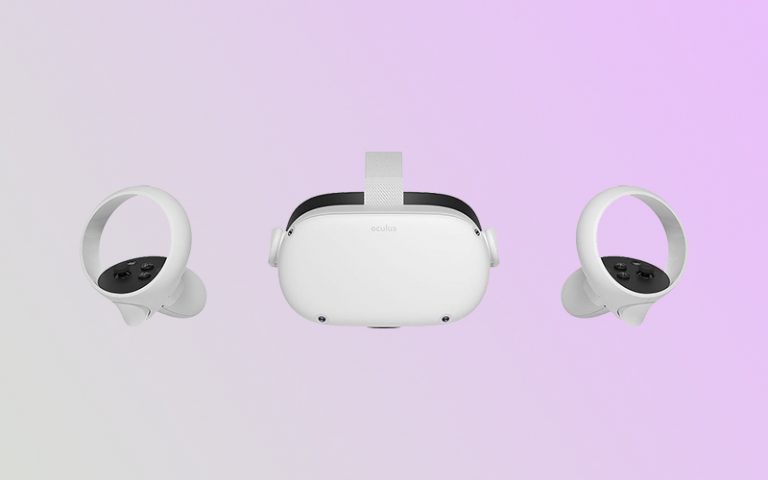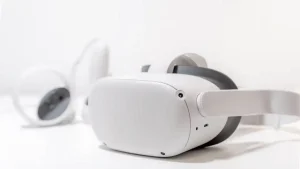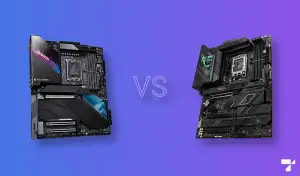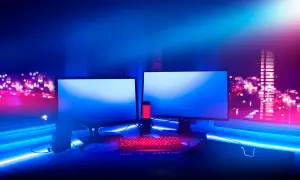Don’t be fooled by classic listings of Oculus VR system requirements. When connected to a PC, you’re not getting anywhere near good enough settings and frame rates without at least investing in a modern (Ryzen 3000/Intel 10th Gen or later) 4-core processor and a Geforce GTX 1060 6GB or Radeon RX 580 graphics card. Even then, your resolution would most likely require scaling down to achieve the minimum frame rates necessary for an improved immersive experience.
Of course, there will still be some variations between Oculus VR headsets, which we will point out through our system recommendations below. Though you have to remember, it’s not just enjoyability that is at stake when playing VR at less optimal hardware configuration. Your very well-being is involved. Visually disturbing sub-60 Hz refresh rates aside, intermittent stutters, and screen flickering would outright cause motion sickness if not paid attention to properly. But that should be a worry as long as your PC meets at least the minimum system requirements provided below.
How to Check Your Computer Specs
How to Check if Your Computer is VR Ready
Aside from comparing the relative performance of your individual CPU and GPU to systems that have been tested on actual VR games, you can also use several benchmarking tools to get a more quantitative measurement.
For example, the SteamVR Performance Test uses a 2-minute rendered in-game sequence, determining if your system can handle the resolution and can maintain the target 72 FPS throughout the brief session. Aside from a base performance chart and score, you will also get an assessment of which components are the bottlenecks, those that would require upgrades or replacement.
Other VR benchmarking tools available for the Oculus Quest and Quest 2:
- VRMark – more benchmark fine-tuning options, frame-by-frame analysis
- FCAT VR – Nvidia’s own VR benchmarking tool
- OpenVR – optimized for actual headset testing and community comparisons
Official website: oculus.com
Oculus Quest and Oculus Quest 2 System Requirements (With Air Link PC)
Official recommended computer requirements for Oculus Quest and Oculus Quest 2
| CPU | Intel Core i5-4590
AMD Ryzen 5 1500X or greater |
| GPU | NVIDIA GTX 970
AMD Radeon RX 480 or greater |
| Memory | 8GB+ RAM |
| OS | Windows 10, Windows 11 |
| USB Ports | x1 USB 3.0 port |
| Video Out | Strong and stable WiFi connection |
Ideal minimum computer requirements for Oculus Quest and Quest 2
Based on stable frame rates low to medium settings for around 80% scaled resolution per eye targeting 72 FPS average. Use DLSS 2.3 and FSR 2.0 as necessary.
| CPU | AMD Ryzen 3 3100 (4C/8T, Zen 2)
Intel Core i3 10100(F) (4C/8T, 10th Gen Comet Lake) |
| GPU | NVIDIA Geforce GTX 1660
AMD Radeon RX 590 |
| Memory | 16GB+ RAM |
| OS | Windows 10, Windows 11 |
| USB Ports | x1 USB 3.0 port |
| Video Out | Strong and stable WiFi connection |
The ideal recommended computer requirements for Oculus Quest and Quest 2
Based on stable frame rates for medium per-eye 1440p full resolution targeting 75 FPS average.
| CPU | AMD Ryzen 5 3600 (6C/12T, Zen 2)
Intel Core i5 11400(F) (6C/12T, 11th Gen Rocket Lake) |
| GPU | NVIDIA Geforce RTX 2070 Super / Geforce RTX 3060
AMD Radeon RX 5700 XT / RX 6600 XT |
| Memory | 16GB+ RAM |
| OS | Windows 10, Windows 11 |
| USB Ports | x1 USB 3.0 port |
| Video Out | Strong and stable WiFi connection |
Oculus Quest and Oculus Quest 2 supported GPUs
The Oculus Link cable itself is not an absolute necessity, as you can use any third-party cable with one USB-C and one USB Type-A connection at each end. That being said, you still need a sturdy, certified USB 3.0 signal-carrying cable that maintains data fidelity at more than three meters to ensure that no data stutters intermittently occur.
If your GPU has a relatively new architecture (year 2020+) and is not listed here, it is possible to still make the Oculus Quest and Oculus Quest 2 work. There are no absolute guarantees on compatibility, however.
Nvidia GPUs
- NVIDIA GeForce GTX 970
- NVIDIA GeForce GTX 1060 (6GB, Desktop)
- NVIDIA GeForce GTX 1070
- NVIDIA GeForce GTX 1080
- NVIDIA GeForce GTX 1080 Ti
- NVIDIA GeForce GTX 1060M
- NVIDIA GeForce GTX 1650
- NVIDIA GeForce GTX 1650 Super
- NVIDIA GeForce GTX 1660 Super
- NVIDIA GeForce GTX 1660 Ti
- NVIDIA GeForce GTX TITAN X
- NVIDIA GeForce GTX TITAN Black
- NVIDIA RTX 20-Series
- NVIDIA RTX 30-Series
AMD GPUs
- AMD 400 Series
- AMD 500 Series
- AMD 5000 Series
- AMD 6000 Series
- AMD Vega Series
Oculus Rift and Oculus Rift S System Requirements
Official minimum computer requirements for Oculus Rift and Rift S
| CPU | Intel Core i3-6100
AMD Ryzen 3 1200, FX4350 |
| GPU | NVIDIA GTX 1050 Ti
AMD Radeon RX 470 |
| Memory | 8GB+ RAM |
| OS | Windows 10 |
| USB Ports | 1x USB 3.0, 2x USB 2.0 ports |
| Video Out | Compatible HDMI 1.3 video output |
Official recommended computer requirements for Oculus Rift and Rift S
| CPU | Intel Core i5-4590
AMD Ryzen 5 1500X or greater |
| GPU | NVIDIA GTX 1060
AMD Radeon RX 480 or greater |
| Memory | 8GB+ RAM |
| OS | Windows 10 |
| USB Ports | 1x USB 3.0 port |
| Video Out | Compatible DisplayPort output |
Ideal minimum computer requirements for Oculus Rift and Rift S
Based on stable gaming frame rates with low to medium settings for per-eye 1440p full resolution targeting at least 72 FPS on mildly demanding VR titles. Use DLSS 2.3 and FSR 2.0 as necessary for even better framerate stabilization.
| CPU | AMD Ryzen 5 3600 (6C/12T, Zen 2)
Intel Core i5 10400(F) (6C/12T, 10th Gen Comet Lake) |
| GPU | NVIDIA Geforce RTX 2060
AMD Radeon RX 6600 |
| Memory | 16GB+ RAM |
| OS | Windows 10, Windows 11 |
| USB Ports | 3x USB 3.0, 1x USB 2.0 ports |
| Video Out | Compatible HDMI 1.3 video output |
Ideal recommended computer requirements for Oculus Rift and Rift S
Based on stable gaming frame rates with medium settings for per-eye 1440p full resolution targeting 80 FPS average. Again, use DLSS 2.3 and FSR 2.0 as necessary for even better framerate stabilization.
| CPU | AMD Ryzen 5 5600 non-X (6C/12T, Zen 3)
Intel Core i5 12400(F) (6C/12T, 12th Gen Alder Lake) |
| GPU | NVIDIA Geforce RTX 3060 Ti
AMD Radeon RX 6700 XT |
| Memory | 16GB+ RAM |
| OS | Windows 10, Windows 11 |
| USB Ports | 1x USB 3.0 port |
| Video Out | Compatible DisplayPort video output |
Oculus Rift and Oculus Rift S Supported GPUs
All GPUs released at a later date than the ones listed here (Geforce RTX 16-series, 20-series, 30-series, Radeon RX 5000 series, 6000 series, ARC Alchemist) are also officially supported:
Nvidia GPUs
- NVIDIA GeForce GTX 780 Ti
- NVIDIA GeForce GTX 970
- NVIDIA GeForce GTX 980
- NVIDIA GeForce GTX 980 Ti
- NVIDIA GeForce GTX 1060 (3GB, Desktop)
- NVIDIA GeForce GTX 1060 (6GB, Desktop)
- NVIDIA GeForce GTX 1070 (Desktop)
- NVIDIA GeForce GTX 1080 (Desktop)
- NVIDIA GeForce GTX 1080 Ti
- NVIDIA GeForce GTX 980 (Laptop)
- NVIDIA GeForce GTX 1060 (6GB, laptop)
- NVIDIA GeForce GTX 1070 (Laptop)
- NVIDIA GeForce GTX 1080 (Laptop)
- NVIDIA GeForce GTX TITAN
- NVIDIA GeForce GTX TITAN X
- NVIDIA GeForce GTX TITAN Z
- NVIDIA GeForce GTX TITAN Black
- NVIDIA TITAN X (Pascal)
- NVIDIA TITAN XP
- NVIDIA Quadro GP100
- NVIDIA Quadro K6000
- NVIDIA Quadro M5000
- NVIDIA Quadro M5500
- NVIDIA Quadro P4000
- NVIDIA Quadro P5000
- NVIDIA Quadro P6000
- NVIDIA M5000
- NVIDIA M5500
- NVIDIA M6000 (12GB)
- NVIDIA M6000 (24GB)
- NVIDIA RTX 3000 Series (24GB)
AMD GPUs
- AMD Radeon R9 290
- AMD Radeon R9 290X
- AMD Radeon R9 390
- AMD Radeon R9 390X
- AMD Radeon R9 Fury
- AMD Radeon R9 Fury X
- AMD Radeon R9 Nano
- AMD FirePro W9100
- AMD FirePro WX7100
- AMD FirePro WX7100 (Laptop)
- AMD Radeon RX 480
- AMD Radeon RX 570
- AMD Radeon RX 580
- AMD Radeon RX 580 Mobile
Final Thoughts
The Oculus Rift, despite being released as a complete, commercial product in 2016, had the correct design foresight to go with higher 1440p as the minimum fidelity standard. The Oculus Quest and Oculus Quest 2 at least though, for the most part, provided that portable VR gaming experience regardless of the enormous hardware challenges of these display requirements.
In fact, this focus on picture quality is still reflected in how the Oculus product series maintained almost the same resolution throughout the years. Later products simply opted for small reductions, in favor of higher refresh rates, even as we crawl very slowly towards high-refresh-rate 4K gaming. Thus, for the foreseeable future, any reliable 1440p (per-eye) gaming setup should be able to take on VR gaming using the Oculus VR headsets without having to worry about taking the user on a figurative vomit comet.



